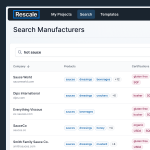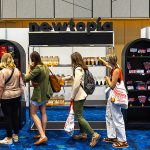Plant-Based Producers Invest In R&D

Last week plant-based producers Quorn and Planterra Foods announced the opening of new R&D facilities to help accelerate their respective innovation pipelines. For both companies, establishing new U.S.-based headquarters labs and testing facilities not only speaks to the importance of the North American market, but also how heavily plant-based CPG companies rely on innovation in order to gain share.
What did Quorn Announce?
Back in May, Quorn’s parent company, Philippines-based noodle company Monde Nissan, told Bloomberg that it planned to use some of the proceeds from its billion dollar IPO to deepen the plant-based meat brand’s presence in the U.S., with an emphasis on its chicken alternative products.
This week’s announcement of the new Texas culinary center makes good on that commitment. In addition to developing new products, the new center will feature kitchens modeled after a variety of restaurant environments, from fine dining to quick service, and will teach food service operators how to utilize mycoprotein, the base of Quorn’s meat alternatives.
Alongside the opening, Quorn also announced the appointment of Judd Zusel (formerly the VP and GM of Bacardi’s Incubation Brands business unit) as president and Stephen Kalil (who has worked in culinary development for The Cheesecake Factory, Chili’s Grill & Bar, PepsiCo and Frito Lay) as executive chef.
What did Planterra Announce?
Last week, Brazilian meat giant JBS Foods announced it would open a new U.S. office and R&D Center for Planterra, its plant-based product division, in Lafayette, CO. Last year Planterra launched its first product line: Ozo, a line of meat alternatives made from fermented rice and pea protein.
The office can support roughly 100 employees, who will focus on developing both new product lines and ingredients.
Though JBS’s headquarters are in South America, the company also maintains a Colorado office and has more than 62,000 U.S. employees across 28 states and Puerto Rico. Planterra, which currently has 46 employees, previously operated out of an office in Denver, but will transition that location to focus on production, with back office employees moved to Lafayette.
What’s the opportunity?
Despite the sizeable growth of the plant-based meat alternative category, companies feel there’s still money on the table and consumers are eager for new products across channels. According to data released by the Plant Based Foods Association and The Good Food Institute, in 2020 retail sales of plan-based foods increased 27%, with the total plant-based market valued at $7 billion. Meat alternatives (which the PBFA and GFI note is the second-largest plant-based category) accounted for much of that growth, rising 45% to $1.4 billion.
Still, it’s a competitive category, and even larger players have found that they can’t rest on the success of prior product lines. Though it has one of the top burger alternatives, Beyond Meat, for example, has been touting plant-based chicken as its next blockbuster launch.
But man cannot live on plant-based sausages and burger patties alone: The GFI and PBFA found that the plant-based meat segment has a 63% repeat purchasing rate among consumers, meaning shoppers may always be looking for what’s next. Many of these products currently also rely on the same basic manufacturing technology — extrusion — and, in some cases, the same copackers, so creating differentiation often comes down to ingredients and how the product is shaped, flavored, packaged and cooked.
Enter the innovation center. Beyond Meat was one of the first major plant-based brands to tout its own focus on R&D, announcing in 2018 its plan to open a 26,000 square foot center, known as the Manhattan Beach Project, at their headquarters in El Segundo, California.
Opening an innovation center will be particularly important for Quorn, a legacy brand in the category that has seen success overseas, but which hasn’t prioritized growth in the U.S.. Having boots on the ground in Texas will allow the company to better adjust its products to the American palate.
“While there are so many benefits to Quorn products and mycoprotein, awareness within the U.S. is still relatively low. Quorn is looking to up its presence in the U.S. and use the Culinary Development Center to highlight the meat alternative’s accessibility and efficiency,” Zusel said. “In addition, our goal is to create world-class innovation to delight consumers and sync up to U.S. consumer trends and taste profiles.”
Both brands will also need to target a key channel for the plant-based meat category: food service. Co-branded menu items at restaurants — such as Beyond Meat’s and KFC’s chicken tenders or Burger King and Impossible’s plant-based Whopper — have been a popular marketing strategy for plant-based brands, helping drive awareness and trial of new items. By partnering with some of the most well-known brands and chefs, plant-based companies have been able to take something unfamiliar and add a layer of context.
Culinary innovation centers also offer food service providers, restaurant chains and chefs the opportunity to experiment with these products first hand, while also surrounded with professionals who can help them adjust cooking methods to new proteins. In QSR environments in particular, repetition is key and operators are looking for products that are easy to cook by thousands of employees, and that ideally utilize existing equipment.
Quorn has already dabbled in foodservice, holding multiple month-long “Quornucopia Kitchen” pop-ups around the country last year. Each popup was hosted inside of a local, fast casual eatery, but maintained its own menu and delivery service.
“For us, Quornucopia Pop-Up Kitchen provides a way to drive awareness and trial around our products and it’s mutually beneficial for our restaurant partners,” said Lucia Caamano, Director of Marketing & Innovation at Quorn Foods USA. “Restaurants that partner with Quornucopia Kitchen get to keep the revenue earned from the pop-up… [and] partnering with cutting-edge vegan and vegetarian restaurants has also proven to be a valuable opportunity to capture direct feedback from our consumer and retail partners.”
















